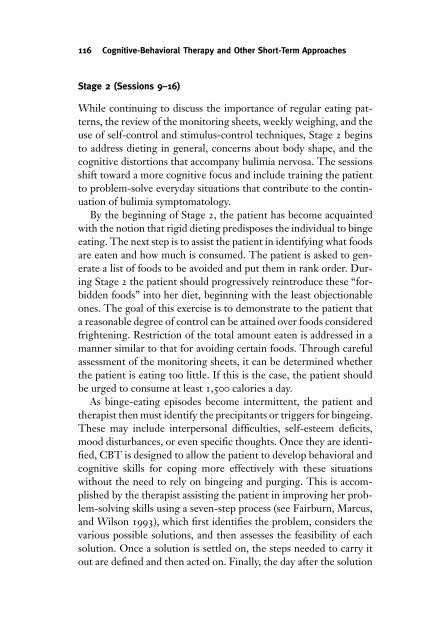Eating Disorders - fieldi
Eating Disorders - fieldi
Eating Disorders - fieldi
Create successful ePaper yourself
Turn your PDF publications into a flip-book with our unique Google optimized e-Paper software.
116 Cognitive-Behavioral Therapy and Other Short-Term Approaches<br />
Stage 2 (Sessions 9–16)<br />
While continuing to discuss the importance of regular eating patterns,<br />
the review of the monitoring sheets, weekly weighing, and the<br />
use of self-control and stimulus-control techniques, Stage 2 begins<br />
to address dieting in general, concerns about body shape, and the<br />
cognitive distortions that accompany bulimia nervosa. The sessions<br />
shift toward a more cognitive focus and include training the patient<br />
to problem-solve everyday situations that contribute to the continuation<br />
of bulimia symptomatology.<br />
By the beginning of Stage 2, the patient has become acquainted<br />
with the notion that rigid dieting predisposes the individual to binge<br />
eating. The next step is to assist the patient in identifying what foods<br />
are eaten and how much is consumed. The patient is asked to generate<br />
a list of foods to be avoided and put them in rank order. During<br />
Stage 2 the patient should progressively reintroduce these “forbidden<br />
foods” into her diet, beginning with the least objectionable<br />
ones. The goal of this exercise is to demonstrate to the patient that<br />
a reasonable degree of control can be attained over foods considered<br />
frightening. Restriction of the total amount eaten is addressed in a<br />
manner similar to that for avoiding certain foods. Through careful<br />
assessment of the monitoring sheets, it can be determined whether<br />
the patient is eating too little. If this is the case, the patient should<br />
be urged to consume at least 1,500 calories a day.<br />
As binge-eating episodes become intermittent, the patient and<br />
therapist then must identify the precipitants or triggers for bingeing.<br />
These may include interpersonal difficulties, self-esteem deficits,<br />
mood disturbances, or even specific thoughts. Once they are identified,<br />
CBT is designed to allow the patient to develop behavioral and<br />
cognitive skills for coping more effectively with these situations<br />
without the need to rely on bingeing and purging. This is accomplished<br />
by the therapist assisting the patient in improving her problem-solving<br />
skills using a seven-step process (see Fairburn, Marcus,<br />
and Wilson 1993), which first identifies the problem, considers the<br />
various possible solutions, and then assesses the feasibility of each<br />
solution. Once a solution is settled on, the steps needed to carry it<br />
out are defined and then acted on. Finally, the day after the solution









